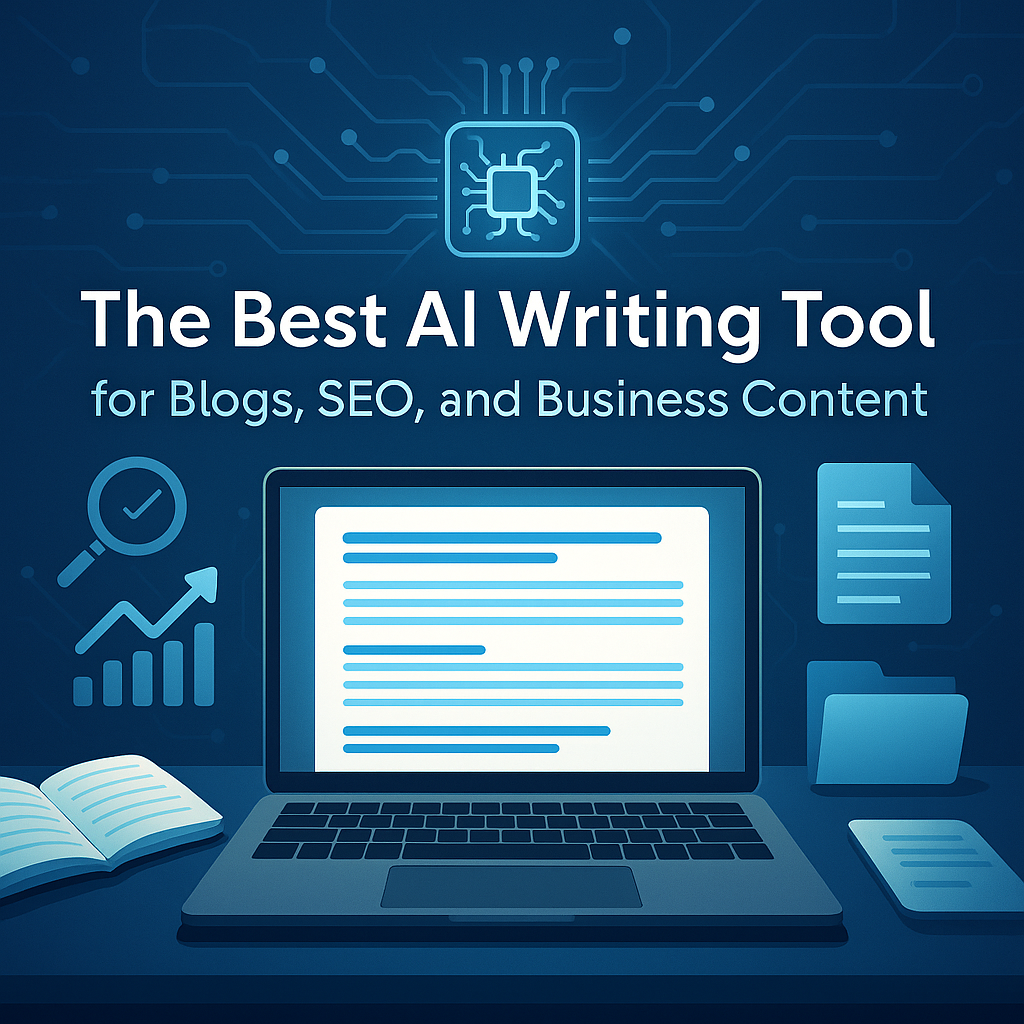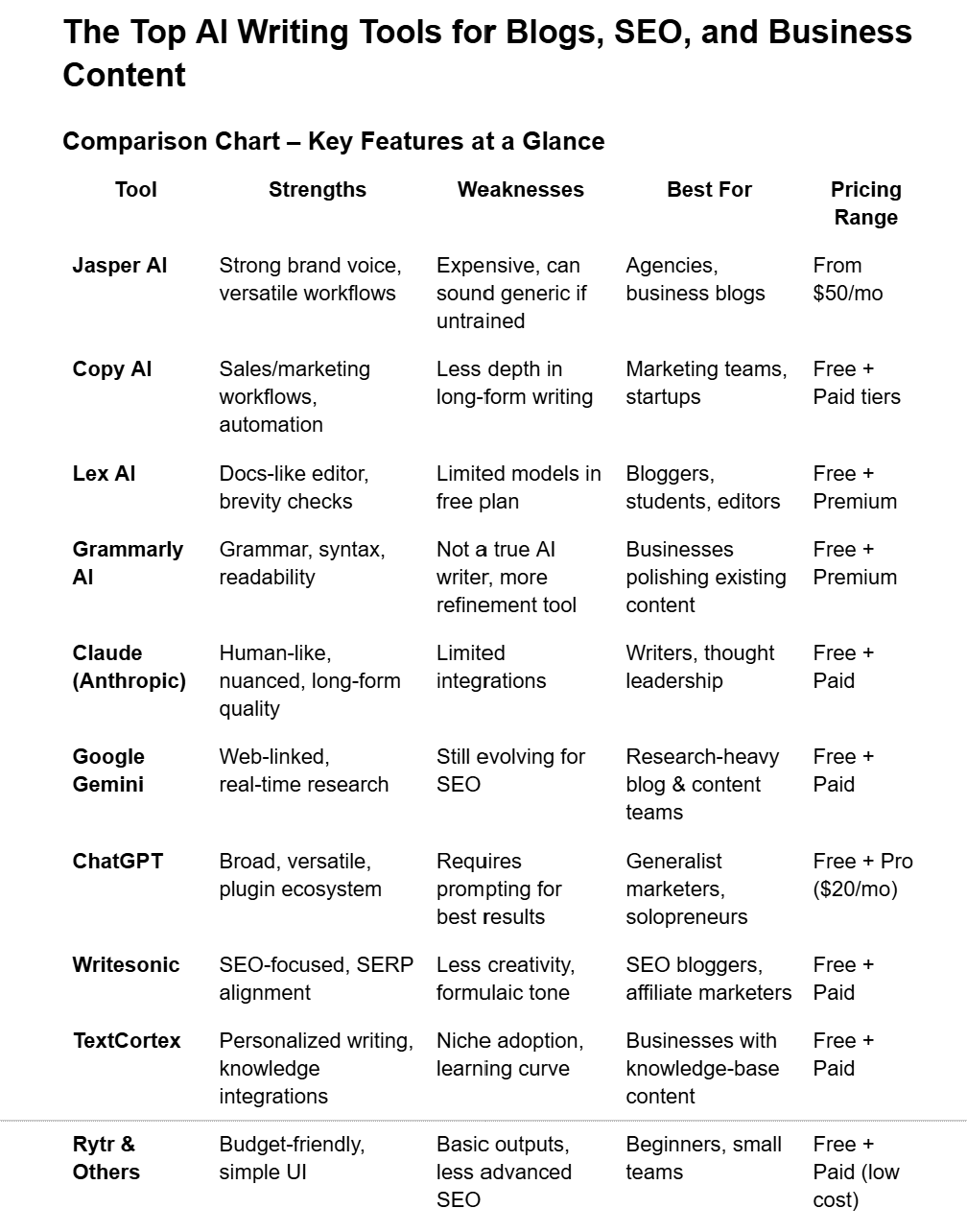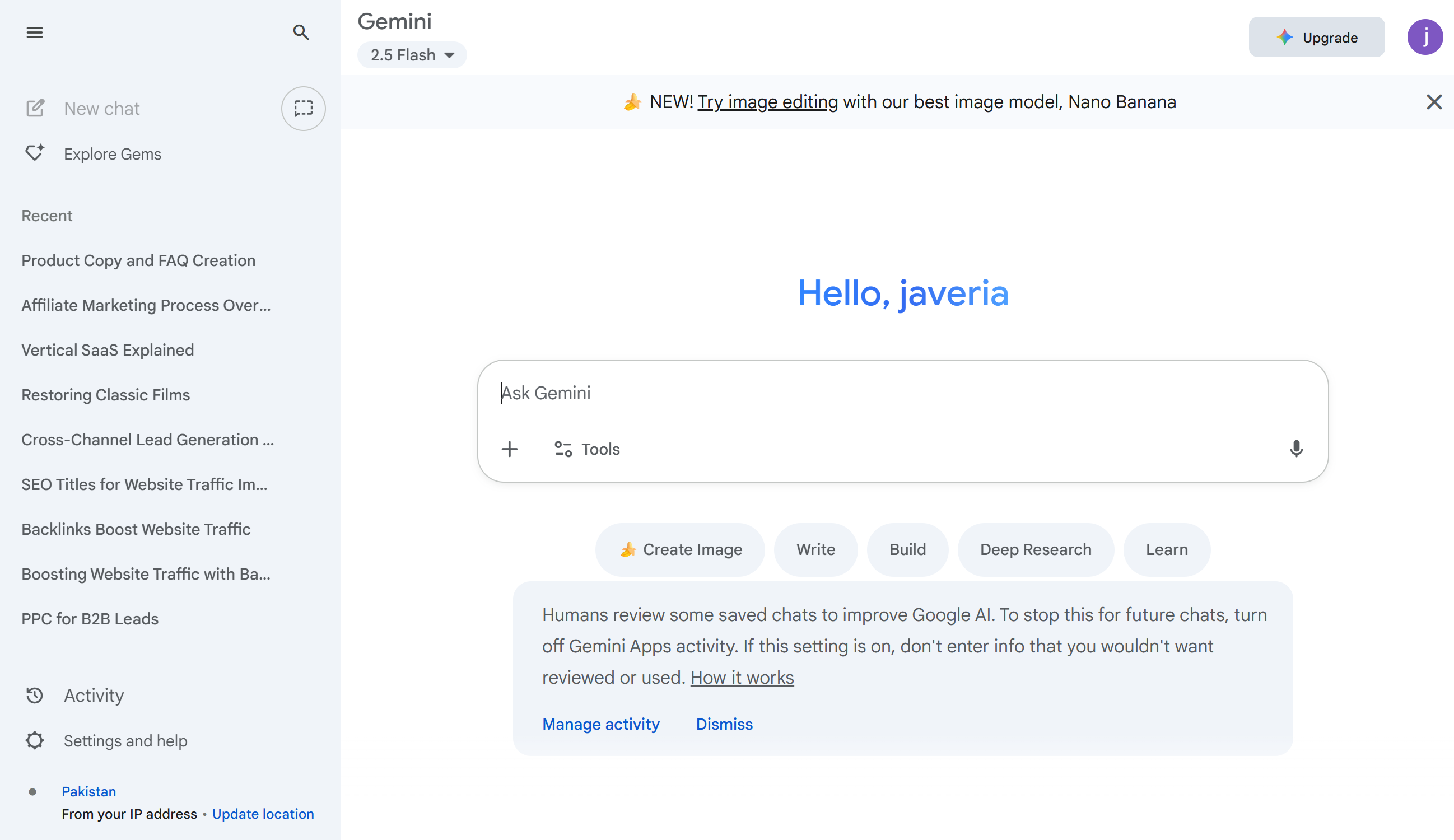The Best AI Writing Tool for Blogs, SEO, and Business Content

Introduction
AI content creation has exploded in recent years. From blogs and social posts to business whitepapers, there’s no shortage of platforms promising quick, polished results with a single click. But as exciting as this shift is, not all tools are equal. Too many churn out text that feels generic, robotic, or SEO-stuffed—the kind of content that fills space without building trust or authority.
That’s the real challenge today. A flood of machine-written articles means readers, clients, and search engines are becoming sharper at spotting fluff. What we need is not just speed, but depth—content that captures nuance, context, and voice while still meeting search intent.
This is where choosing the best AI writing tool makes all the difference. The strongest platforms today are more than just text spitters. They act as AI-powered writing assistants, guiding structure, refining tone, and ensuring originality. A well-designed AI content generator doesn’t just save time—it helps creators think smarter, write clearer, and publish content that resonates.
In this article, I’ll break down why AI writing tools matter now more than ever, what criteria smart marketers should consider, and which platforms truly stand out. We’ll look beyond hype to explore features, risks, and practical applications for blogs, SEO, and business writing. By the end, you’ll know exactly what to expect from the top tools—and how to choose one that elevates your content strategy instead of holding it back.
Why AI Writing Tools Matter in 2025
As we step deeper into 2025, the role of AI in content is undeniable. Search behavior itself is evolving. Google’s AI overviews have reduced traditional click-throughs by up to 40% in some niches, while platforms like TikTok and YouTube are emerging as serious discovery engines. If brands want to stay visible, they can’t rely on old tactics like keyword stuffing or mechanical backlinking. They need adaptive strategies—and that means leveraging smarter AI tools.
The demand for an AI content optimization tool is higher than ever. Marketers want platforms that analyze SERPs in real time, cluster semantic keywords, and deliver content that aligns with Google’s evolving understanding of quality. Bloggers, on the other hand, are increasingly turning to an AI blog post generator with SEO features to maintain publishing consistency while focusing on ideation and storytelling.
But there’s a common concern: too many tools sound the same. As I’ve observed, a lot of outputs are overhyped, cliché, or shallow. They meet a word count but fail to engage. That’s why the distinction between tools that write for you versus tools that work with you is critical. The best AI writing tools don’t strip away the human element; they augment it. They guide writers to refine tone, expand on ideas, and avoid that dreaded “AI blandness” that readers tune out.
In other words, these tools matter not because they replace writers, but because they empower us to meet higher standards of speed, scale, and creativity without sacrificing authenticity. That’s the edge every content creator, SEO professional, and business writer needs right now.
Key Criteria for Choosing the Best AI Writing Tool
The market is crowded with dozens of tools, but not every shiny product will serve your needs. From my experience, the best way to evaluate them is by focusing on five essential criteria: content quality, SEO features, personalization, ease of use, and pricing.
Content Quality & Human-Like Writing
This is the heart of the matter. If a tool can’t produce writing that feels natural, empathetic, and useful, it’s not worth your time. Many platforms still produce generic and cliché-sounding drafts, which erode credibility. The best AI writing tools should create text that matches human rhythm and adapts to context, offering clarity and depth rather than filler.
Keyword Research & SEO Features
A modern writing platform must double as an AI tool for keyword research and optimization. This goes beyond basic suggestions. I look for tools that cluster semantically related terms, run predictive analytics, and optimize readability alongside keyword placement. These features ensure content isn’t just written—it’s positioned to rank.
Personalization & Brand Voice
The strongest tools today use NLP to align outputs with your unique brand voice. Many even allow users to upload brand guidelines or sample content for training. That means you can generate a blog post that doesn’t just sound polished, but also sounds like you. This capability is essential for businesses that want consistency across marketing and customer communication.
Ease of Use & Integrations
Even the most advanced AI won’t be adopted if the interface is clunky. I evaluate how intuitive the design is and whether the tool integrates smoothly with Google Docs, Sheets, CMS platforms, or project management tools. A seamless workflow saves more time than advanced features hidden behind poor UX.
Pricing & Value for Money
Cost remains a big factor. Some premium AI tools like Jasper start at $50/month, while others provide strong free versions or affordable tiers. When evaluating pricing, it’s not just about cost—it’s about ROI. Does the tool help you publish faster, rank higher, or scale content without adding more editors? The value should justify the spend.
The Top AI Writing Tools for Blogs, SEO, and Business Content
Comparison Chart – Key Features at a Glance

Jasper AI

Jasper is one of the most well-known players in the market. Its biggest advantage is its ability to generate long-form content aligned with a brand voice. Businesses love the fact that Jasper lets them upload tone and style guidelines, ensuring output matches their existing identity.
Pros: Versatile across blogs, ad copy, and business content. Strong personalization features for brand voice.
Cons: As noted in transcripts, Jasper can sometimes produce generic or cliché writing if prompts aren’t refined. It’s also among the pricier options, starting at $50/month.
Best For: Agencies and businesses that prioritize consistent brand messaging.
Copy AI

Copy AI shines with workflow automation designed for marketing and sales teams. Its templates are geared toward ad copy, emails, and campaigns—helping companies scale without constant manual input.
Pros: Excellent for social media posts, product descriptions, and sales-focused writing. Time-saving automation.
Cons: Less depth when it comes to thoughtful, long-form blogs or research-based SEO.
Best For: Startups and marketing teams that need a high output of short, punchy copy.
Lex AI

Lex is a newer tool that feels like a Google Docs alternative with AI built-in. Writers love its brevity checks, collaborative editing, and grammar suggestions. It’s not flashy, but it’s incredibly practical.
Pros: Clean interface, easy for bloggers and students. Strong at improving readability.
Cons: Limited to fewer models in the free version.
Best For: Bloggers, editors, and content teams who want AI integrated into their daily workflow.
Grammarly AI

While Grammarly isn’t a full AI content generator, its AI writing assistant features make it invaluable. It ensures writing is grammatically flawless, readable, and polished.
Pros: Great for refining drafts, improving syntax, and catching mistakes. Perfect add-on to any other AI writing workflow.
Cons: Doesn’t generate original long-form content; works best as a complementary tool.
Best For: Business teams and professionals who prioritize polished, error-free content.
Claude (Anthropic)
.png)
Claude stands out for its human-like depth and empathy in writing. It creates content that feels more nuanced than many competitors—making it a favorite for long-form, thought leadership, or creative writing.
Pros: Natural, engaging writing that avoids robotic tone. Great for ideation.
Cons: Limited integrations with content platforms.
Best For: Writers and brands that need authentic, human-like storytelling.
Google Gemini

Gemini, Google’s AI writing assistant, integrates live web results into its outputs. This makes it powerful for real-time SEO and research-driven content.
Pros: Access to up-to-date information, strong integration with Google’s ecosystem.
Cons: Still developing its SEO-specific workflows.
Best For: Research-heavy blogs, news-style content, or business writers.
ChatGPT (OpenAI)
.png)
ChatGPT is the most versatile generalist tool on the market. With its plugins and reasoning capabilities, it works across industries and content types.
Pros: Huge versatility—everything from blogs to scripts to SEO research. Plugin ecosystem adds functionality.
Cons: Requires prompting skills; otherwise outputs can be broad or generic.
Best For: Solopreneurs, generalist marketers, and small teams.
Writesonic

Writesonic is tailored for SEO writing. It creates content structured to rank on search engines, with features like SERP analysis and content scoring.
Pros: Produces blog posts optimized for keywords. Great for affiliate marketers.
Cons: Less creativity—outputs can feel formulaic.
Best For: SEO bloggers and content marketers who prioritize rankings.
TextCortex

TextCortex differentiates itself with knowledge-base integration, meaning it can pull from your own documents or databases to generate content. This makes it ideal for businesses that need precise, personalized writing.
Pros: Great for business writing and internal knowledge-based content. Customizable.
Cons: Niche adoption, higher learning curve.
Best For: Companies with large knowledge systems or niche content needs.
Rytr & Other Emerging Tools

For budget-conscious teams, Rytr and similar tools provide straightforward writing assistance at low cost. While they lack the advanced SEO or personalization features of Jasper or Writesonic, they’re ideal for beginners.
Pros: Affordable, user-friendly, and effective for simple content.
Cons: Limited depth and SEO features.
Best For: Small teams, students, or entry-level bloggers.
AI Writing Tools for Specific Use Cases
Best AI Writing Tool for Blogs & Content Marketing
When it comes to blogging, consistency and SEO alignment are key. Tools like Writesonic and Jasper stand out because they act as both an AI blog post generator with SEO features and a structured workflow manager. Writesonic integrates with SERP data to help align drafts with what search engines favor, while Jasper adds personalization and tone matching so blogs don’t sound identical.
From transcripts, one recurring point was that content must avoid the generic AI sound. This is where personalization and style training matter most—helping bloggers publish quickly without losing originality.
Best picks for blogs: Jasper, Writesonic, Lex.
Best for SEO & Technical Optimization
For those prioritizing visibility on Google, the best AI writing tool is one that doubles as an AI content optimization tool. Writesonic’s SEO features, paired with integrations from Surfer SEO, give writers the ability to hit both keyword density and semantic breadth. SEMrush’s AI writing add-ons are also valuable for technical optimization, ensuring schema and meta elements are not overlooked.
Best picks for SEO: Writesonic, Surfer SEO integrations, SEMrush AI writer.
Best for Business Copywriting & Branding
Business writing requires precision and tone consistency. Copy AI is a strong choice here, thanks to its sales and marketing workflows. Grammarly AI complements this by refining clarity, grammar, and professionalism. For enterprises, Jasper’s brand voice training ensures every piece of copy aligns with identity guidelines—whether it’s ad copy, press releases, or website content.
Best picks for business writing: Copy AI, Jasper, Grammarly AI.
Best for Creative Writing & Fiction
Creativity is where many AI tools struggle, often defaulting to formulaic outputs. Claude by Anthropic excels here, producing long-form, empathetic, and nuanced writing. Writers appreciate its ability to ideate and draft without sounding robotic. ChatGPT also remains popular among creative writers for its adaptability, especially when paired with strong prompts.
Transcript insights highlighted the importance of tools that help with you, not for you. Claude embodies this by acting less like a machine and more like a thoughtful co-writer.
Best picks for creativity: Claude, ChatGPT.
Risks & Limitations of AI Writing Tools
The surge of AI platforms has brought incredible opportunities—but it’s equally important to be aware of their weaknesses. Even the best AI writing tool is not flawless, and relying on them without oversight carries risks.
Generic and Cliché Output
As noted in the transcripts, many tools still produce text that feels generic or cliché. This happens when algorithms over-prioritize patterns, leading to content that technically reads well but lacks originality. For marketers and SEO professionals, that kind of content can backfire, damaging brand trust.
Ethical and Originality Concerns
Another limitation is originality. While most AI content generators claim to create unique material, outputs often resemble existing phrasing from training data. Businesses and students must still use plagiarism checkers and ensure they’re not pushing content that borders on duplication. Some teams combine their AI workflow with an AI plagiarism checker and originality tool to minimize risks.
Over-Reliance and Misuse
There’s also the danger of over-reliance. Tools that do the work for you can tempt users into cutting corners. The best approach is selecting platforms that work with you—guiding, enhancing, and optimizing without replacing critical thinking. Without human editing, content risks becoming hollow or misaligned with brand identity.
ROI and Cost Challenges
Finally, pricing can be a limitation. Premium models like Jasper deliver excellent outputs but start at $50/month, which can be restrictive for small teams. Meanwhile, free tools often add watermarks, cap word counts, or limit features. This makes choosing the right balance of features vs. cost essential.
In short, while AI tools offer speed and scale, they aren’t a replacement for creativity, originality, or human oversight. They’re powerful allies—but only when used wisely.
Best Practices for Using AI Writing Tools
Even the best AI writing tool can’t guarantee great results without a smart workflow. From my experience, success comes from combining automation with human creativity and careful editing. Here are a few proven practices to maximize value.
Combine AI + Human Editing
AI can handle speed and scale, but writers must refine for empathy, accuracy, and originality. I recommend treating every AI-powered writing assistant as a co-writer, not a replacement. Run drafts through manual editing, check tone, and ensure alignment with your audience’s needs.
Test Across Multiple Tools
No single tool is perfect. Some platforms shine as an AI blog post generator with SEO features, while others excel at refining grammar or injecting brand personality. Testing across Jasper, Writesonic, Grammarly AI, and Claude will give you a sense of which combination delivers the best ROI for your workflow.
Don’t Over-Automate
Over-automation is a common trap. Content that’s rushed through a tool without review often ends up generic and uninspiring. Use features like AI tools for keyword research and optimization, but avoid the temptation to let the platform write everything from start to finish.
Leverage Integrations
Many tools integrate with Google Docs, Sheets, and CMS platforms. Using these integrations ensures smoother collaboration and better efficiency. For business teams, this can mean the difference between a slow, fragmented process and a streamlined publishing system.
Check for Originality
Finally, always run content through an AI plagiarism checker and originality tool before publishing. This small step prevents ethical issues and ensures your content is unique enough to stand out.
By combining these practices, marketers and writers can turn AI from a shortcut into a strategic advantage—one that elevates creativity instead of replacing it.
Conclusion
The surge of AI in content writing has changed the game. With so many options available, choosing the best AI writing tool isn’t about finding a one-size-fits-all solution—it’s about identifying the platform that aligns with your goals. For bloggers, that might mean a tool with strong SEO workflows; for businesses, one that ensures brand voice consistency; for creatives, an assistant that delivers depth and nuance.
Across my testing, one theme stood out: the strongest tools don’t replace writers, they empower them. A good AI-powered writing assistant helps refine ideas, structure articles, and optimize for search, while still leaving room for human judgment and creativity. Pairing automation with editing is the key to avoiding generic or robotic results.
The industry will only keep evolving. We’re already seeing AI content optimization tools with real-time SERP analysis, AI blog post generators with SEO features, and even systems trained on individual brand voices. The future is less about shortcuts and more about synergy—AI and humans working together to raise the bar for content quality.
My advice: experiment with different platforms, find your workflow sweet spot, and treat AI as a creative partner. The right tool won’t just save time—it will help you write smarter, rank higher, and connect more authentically with your audience.
